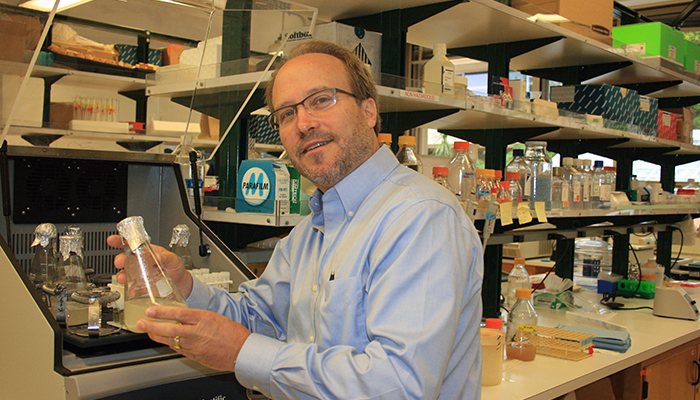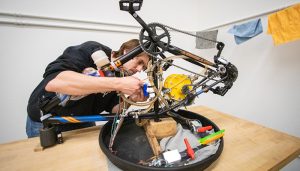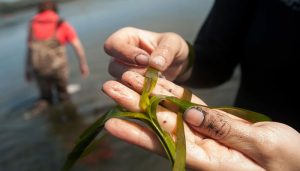September 26, 2023
Legumes are the second largest family of agricultural plants. In the developing world, where there’s a high fraction of vegetarians or where meat isn’t affordable, legumes –– such as common bean, chickpea and lentil –– are a primary protein source for human health and nutrition.
For nearly three decades, researchers in the Cook Lab at UC Davis have focused on studying nitrogen fixation in legumes, a process that imbues them with high protein content. Nitrogen fixation creates valuable ammonia from atmospheric nitrogen gas, which is then assimilated by the plant into amino acids that are used to build proteins. Ready access to “reduced nitrogen” makes legumes vital components of agriculture, enriching soil and plant health while providing vital dietary protein for humans and animals.
After years studying fundamental mechanisms of nitrogen fixation, Douglas Cook, a professor in the College of Agricultural and Environmental Sciences, became especially motivated to understand mechanisms in legume crops that can lead to more efficient agriculture. For Cook, this means developing data and tools to discover mechanisms controlling agronomic traits, including disease resistance, nitrogen fixation, and sustainability traits. Cook also recognizes the importance of commercializing technology to maximize the impact of his work. In 2019 Cook partnered with his daughter Kathryn Cook, a technical program manager with an extensive background in product development across multiple industries, and Brendan Riely, a former postdoctoral student, to found NuCicer – a food and agricultural start-up to advance technologies emerging from his lab towards commercial applications. NuCicer’s mission is to unlock the full potential of chickpea as a staple crop in our food system, starting with naturally increasing protein content in the crop by 75%.
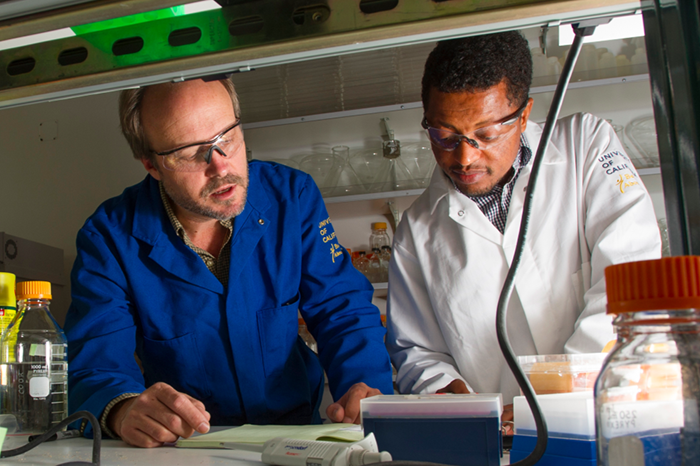
Researchers in the Cook Lab at UC Davis have focused on studying nitrogen fixation in legumes, a process that imbues them with high protein content.
Adjusting focus towards agriculture
In the early 2000s, Cook moved from studying legumes as genetic models for nitrogen fixation, to studying legume crops as the source of agricultural traits. This transition involved building ties to the developing world, including in Ethiopia, India, Pakistan, and the Turkey, where legume crops are heavily relied upon for agricultural sustainability and human health.
“Gradually, beginning around 2003, we started focusing more and more on chickpeas, and there are a couple of reasons for doing that,” Cook said. “The first is that chickpea is a close relative of the model species that the team has always worked on, an organism known as “Medicago trunctula”. “This close evolutionary relationship meant that knowledge gained in the model legume could be readily translated to chickpeas and ultimately to agricultural outcomes.”
Secondly, “On the basic science side, I was very interested in the origins and function of genetic diversity in the wild systems from which agriculture originated,” Cook stated. “On the applied side, I wanted to understand how, ten thousand years ago, humans shaped a crop from a wild species. Might the process of crop domestication have left behind valuable agricultural traits in the wild?” Chickpea provided an ideal system to ask such questions.
The fact that the chickpea was taken from southeastern Turkey and distributed globally made Cook think about its enormous journey through time and geographic regions and how that may have played a role in shaping the crop as it is today. “Did that process create crops that were less effective than they could be? How could we go back and harness wild diversity to make modern crops more effective?” are some of the questions Cook investigated.
To explore these questions Cook obtained funding from numerous governmental and non-profit sources, including the US Agency for International Development, the US National Science Foundation, and the Australian Grains Research and Development Corporation, allowing creation of an international network of 32 different institutions in 12 countries.
In pursuit of agricultural traits
Beginning in 2014, Cook and colleagues began exploring the origins of chickpea’s wild diversity in Southeastern Turkey. Working under international agreements, the team expanded the known genetic diversity of chickpea’s wild progenitor species by ~40X and used a combination of genomics and genetics to understand the impacts of crop domestication.
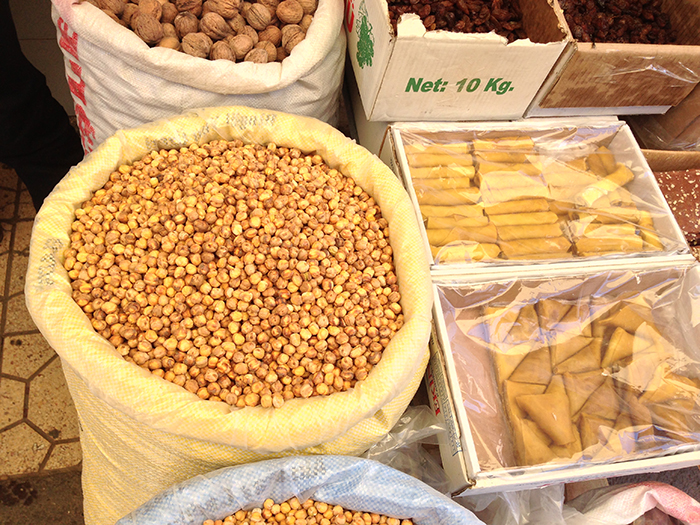
Chickpeas in Turkish market.
A cornerstone of this effort was a large genetic population, developed over several years, that combines genes from wild and cultivated sources into thousands of new genetic lineages. This biological resource provided the basis for trait discovery and breeding of new crops.
In one project, the Australian Grains Research and Development Corporation, which is a grower-focused funding agency, engaged the Cook lab to solve the emerging problem of soil acidity. Under acidic conditions, toxic aluminum enters the soil solution, which in turn retards plant growth and reduces crop yields. Harnessing the power of their wild germplasm collection, members of the Cook lab discovered a trait in the wild species that allows cultivated chickpea to grow in the presence of toxic aluminum. Armed with detailed genomic data, the lab is working in parallel to (1) understand the mechanism by which the wild trait confers tolerance to aluminum, and (2) to breed new aluminum tolerance varieties of chickpea with enhanced agricultural yields. As explained by Cook, “Soil effects are often subtle, impacting yields even when the occurrence of soil stress is not recognized. This new trait for aluminum tolerance has considerable potential to increase chickpea yields across large acreage.”
In a parallel project, with funding from the US Department of Agriculture’s Pulse Crop Health Initiative, members of the Cook lab are exploring their wild x cultivated germplasm for improved nitrogen fixation. Again, their unique genetic resource has shown its value, helping to develop new chickpea lines that have significantly increased nitrogen fixation relative to commercial chickpea. Nitrogen is the most expensive agricultural input, on par with the cost of agricultural land, and super-nitrogen fixing chickpea has the potential to boost crop yields, reduce agricultural costs, and avoid the negative environmental consequences of nitrogen fertilizers.
Bringing chickpea technology to the market
About the same time as the nitrogen and aluminum projects were taking off, Cook had the idea of looking at the nutritional value in seeds in the lab’s germplasm collection. “I designed a small undergraduate research project to evaluate seed protein content in our germplasm. Unexpectedly, we discovered a wide range of protein content. This data showed the potential to breed for high-protein chickpea,” Cook said. That simple observation became the basis of a new startup, NuCicer.
“NuCicer focuses our rigorous research and development on quality and efficiency traits that create value across the entire food system – from growers to seed processors to food companies and ultimately every-day consumers,” said Kathryn Cook, NuCicer’s CEO. One of the linchpins of NuCicer’s success is the genetic and genomic technology platforms that Cook had spent 30 years developing during his academic career. In the short span of four years the company has grown from a fledgling idea to a potentially impactful agricultural and food technology company. After an initial small grant from the Foundation for Food & Agriculture Research, the company has attracted significant resources from investors.
During the early stages of innovation, NuCicer gained momentum through the UC Davis-HM Clause Life Science Innovation Center, a local UC Davis-affiliated incubator for agricultural start-up companies. Proximity to UC Davis has also provided numerous opportunities for UC’s skilled graduates, with many of NuCicer’s employees being former University of California students and postdocs. Brendan Riely, NuCicer’s third co-founder and a former UC Davis postdoc, commented that, “UC Davis students come equipped with strong science backgrounds, allowing us to quickly adapt their skills to our specific requirements at NuCicer.”
“The past few years of my career have been very gratifying. I spent the better part of three decades working with legume species, on topics that I knew in my heart were important, but not knowing how to deliver real-world outcomes. Now, with opportunities such as those provided by the Australian Grains Research and Development Corporation, the US Department of Agriculture, and NuCicer, I have the means to make good on scientific discoveries that directly impact farmers, consumers and the public,” Cook said.
Media Contact
AJ Cheline, UC Davis Office of Research, 530-752-1101, [email protected]
Neelanjana Gautam, UC Davis Office of Research, [email protected]


